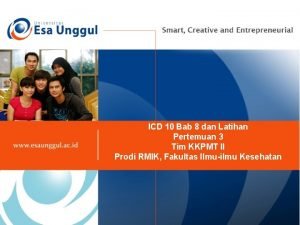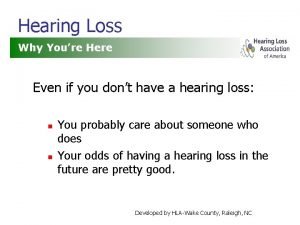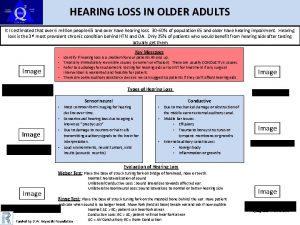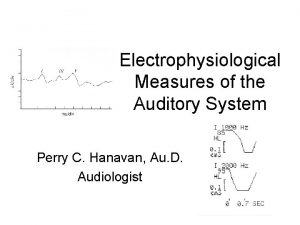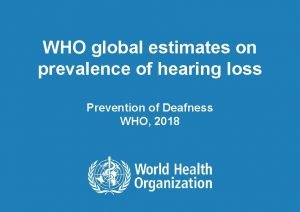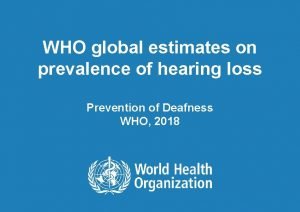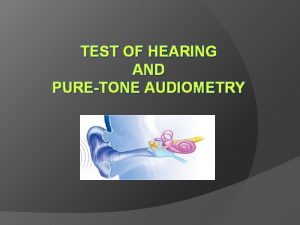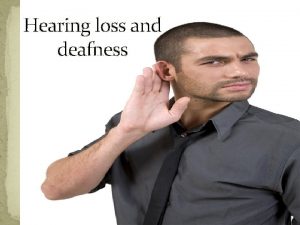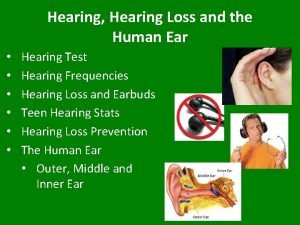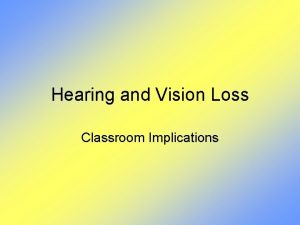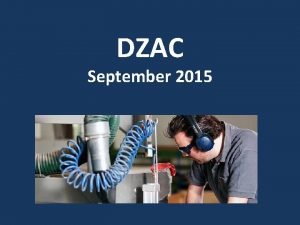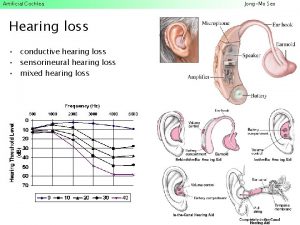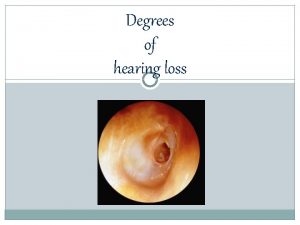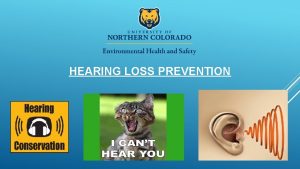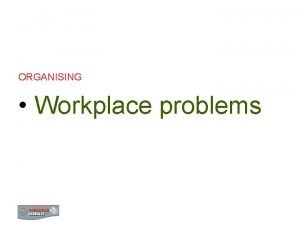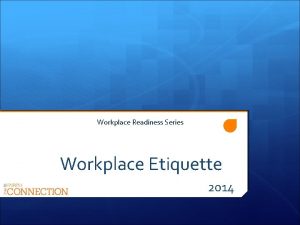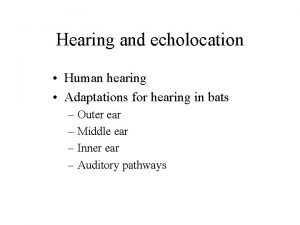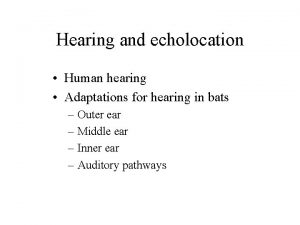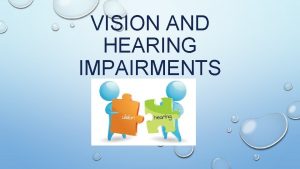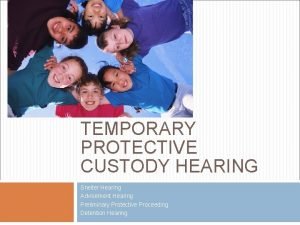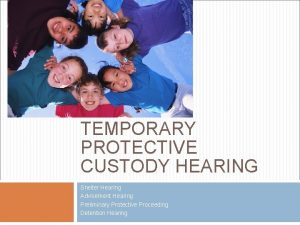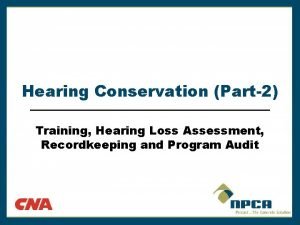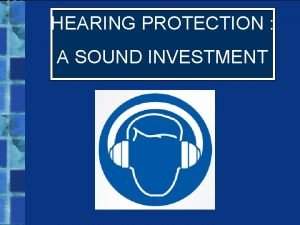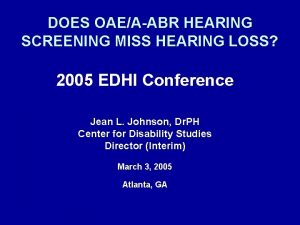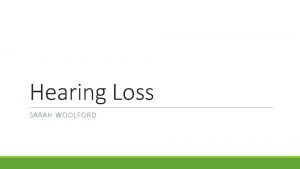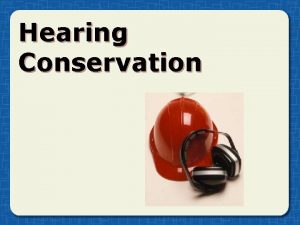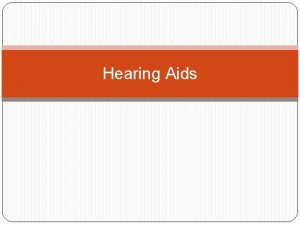Hearing Loss and the workplace Hearing loss has
































- Slides: 32


Hearing Loss and the workplace Hearing loss has been shown to negatively impact nearly every dimension of the human experience including: physical health, emotional and mental health, perceptions of the mental acuity, social skills, family relationships, self-esteem and school and work performance. Hearing is critical to effective communication in the work force. Most employment situations require verbal communication in order to effectively engage in commerce and in dealing with the public and for safety Without aided hearing, data suggests that the hearing impaired individual, including those with mild losses, can be expected to suffer losses in compensation due to underemployment, mistakes on the job and unemployment For those who did collect an income, individuals with hearing loss made about 25% less; their mean wage was $23, 481, compared with $31, 272 for typical-hearing peers. Hearing aids were shown to reduce the risk of income loss by 90 to 100% for those with milder hearing loss, and from 65 to 77% for those with moderate to severe hearing loss.

Implications of Hearing Loss Unilateral Hearing Loss One normal hearing ear and one ear with at least a mild permanent hearing loss: May have difficulty: hearing faint or distant speech difficulty localizing sounds and voices Greater difficulty understanding speech when environment is noisy or reverberant Difficulty detecting or understanding soft speech from side of bad ear, especially in a group discussion.

Implications of Binaural Hearing Loss Minimal (Borderline): 16 -25 d. B Can may have difficulty hearing faint or distant speech miss up to 10% of speech more than 3 feet away when in noisy

Implications of Binaural Hearing Loss Mild: 26 -40 d. B Can experience some difficulty hearing faint or distant speech at 30 d. B can miss 25 -40% of the speech signal; usually will miss consonants, especially if loss is focused in higher frequencies

Implications of Hearing Loss Moderate: 41 -55 d. B Can understand some speech at a distance of 3 -5 feet Amount of speech missed can vary from: 50% - 75% with 40 d. B loss (without aids) 80% - 100% with 50 d. B loss (without aids); high probability of speech and language delay.

Implications of Hearing Loss Moderate to severe: 56 -70 d. B Conversation must be very loud to be understood without amplification Difficulty with verbal communication in both 1 on 1 and group situations Begin to have reduction in understanding (auditory deprivation)

Implications of Hearing Loss Severe: 71 -90 d. B May hear loud voices about one foot from the ear without amplification Can achieve some improvement in hearing and some ability to identify environmental sounds if aided optimally Oral language and speech may not develop spontaneously (if loss is prelingual) or will be severely delayed. If loss is acquired, speech is likely to deteriorate with voice quality becoming atonal. http: //www. facstaff. uww. edu/bradley/radio/hlsimulation/normal_speech 9. mov

Implications of Binaural Hearing Loss Profound: 91 d. B or greater More aware of vibrations than tones or patterns of speech May rely on vision rather than hearing as primary avenue for communication and learning Ability to detect speech sounds with amplification depends on configuration of loss Speech and language will not develop spontaneously and is likely to deteriorate rapidly if loss if of recent onset. http: //www. facstaff. uww. edu/bradley/radio/hlsimulation/normal_speech 9. mov

Changes in hearing aid technology… More power with less feedback More accurate match of hearing gain to hearing loss Improved ear mold materials Improved assistive listening devices (FM) Smaller hearing aid cases More options for daily living assistive devices Increased moisture and dust resistancy More variety of manufacturer accessories

Selecting a Solution Hearing Aid Evaluation Subjective measure Objective measure Questionnaire

Choosing Style Extended Wear

Daily Wear. Completely in the Canal (CIC)

Daily Wear- In the Canal (ITC)

Daily Wear-In the Ear (ITE)

Daily Wear- Behind the Ear (BTE)

Daily Wear. Receiver in the Canal (RIC)

Specialty Aids

What style?

Basic Technology

Standard technology

Advanced technology

Premium Technology

Accessories/ALD’s

Adaptation Process with hearing aids

Cochlear Implants Med-El Cochlear Americas Advanced Bionics


Traditional candidacy

Insurance-hearing aid benefit? Monetary benefit Discount plan Combination



References National Council on the Aging (NCOA): The Impact of Untreated Hearing Loss in Older Americans. Conducted by the Seniors Research Group. Supported through a grant from the Hearing Industries Association. Preliminary Report, 12/28/98. Kochkin S. Quantifying the Obvious: The Impact of Untreated Hearing Loss on Quality of Life, Knowles Electronics, Itasca, IL: May 1999. Kirkwood D: Major survey documents negative impact of untreated hearing loss on quality of life. Hearing Journal 1990: 52(7)L 32 -40. Kochkin S: Marke. Trak V: Baby Boomers spur grown in potential market, but penetration rate declines. Hearing Journal, 1999; 52(1): 33 -48. Powers T: Marke. Trak 10: Hearing Aids in an Era of Disruption and DTC/OTC Devices, 2019:
 Icd 10 infeksi telinga luar
Icd 10 infeksi telinga luar Cookie bite hearing loss
Cookie bite hearing loss Conductive hearing loss lateralization
Conductive hearing loss lateralization Oae results
Oae results Schwabach test interpretation
Schwabach test interpretation Who global estimates on prevalence of hearing loss 2020
Who global estimates on prevalence of hearing loss 2020 Who global estimates on prevalence of hearing loss 2020
Who global estimates on prevalence of hearing loss 2020 Audiogram hearing loss
Audiogram hearing loss The method of unit costing is adopted by
The method of unit costing is adopted by Hình ảnh bộ gõ cơ thể búng tay
Hình ảnh bộ gõ cơ thể búng tay Ng-html
Ng-html Bổ thể
Bổ thể Tỉ lệ cơ thể trẻ em
Tỉ lệ cơ thể trẻ em Gấu đi như thế nào
Gấu đi như thế nào Tư thế worm breton là gì
Tư thế worm breton là gì Bài hát chúa yêu trần thế alleluia
Bài hát chúa yêu trần thế alleluia Môn thể thao bắt đầu bằng chữ f
Môn thể thao bắt đầu bằng chữ f Thế nào là hệ số cao nhất
Thế nào là hệ số cao nhất Các châu lục và đại dương trên thế giới
Các châu lục và đại dương trên thế giới Công của trọng lực
Công của trọng lực Trời xanh đây là của chúng ta thể thơ
Trời xanh đây là của chúng ta thể thơ Cách giải mật thư tọa độ
Cách giải mật thư tọa độ Phép trừ bù
Phép trừ bù độ dài liên kết
độ dài liên kết Các châu lục và đại dương trên thế giới
Các châu lục và đại dương trên thế giới Thể thơ truyền thống
Thể thơ truyền thống Quá trình desamine hóa có thể tạo ra
Quá trình desamine hóa có thể tạo ra Một số thể thơ truyền thống
Một số thể thơ truyền thống Cái miệng xinh xinh thế chỉ nói điều hay thôi
Cái miệng xinh xinh thế chỉ nói điều hay thôi Vẽ hình chiếu vuông góc của vật thể sau
Vẽ hình chiếu vuông góc của vật thể sau Nguyên nhân của sự mỏi cơ sinh 8
Nguyên nhân của sự mỏi cơ sinh 8 đặc điểm cơ thể của người tối cổ
đặc điểm cơ thể của người tối cổ V cc cc
V cc cc
